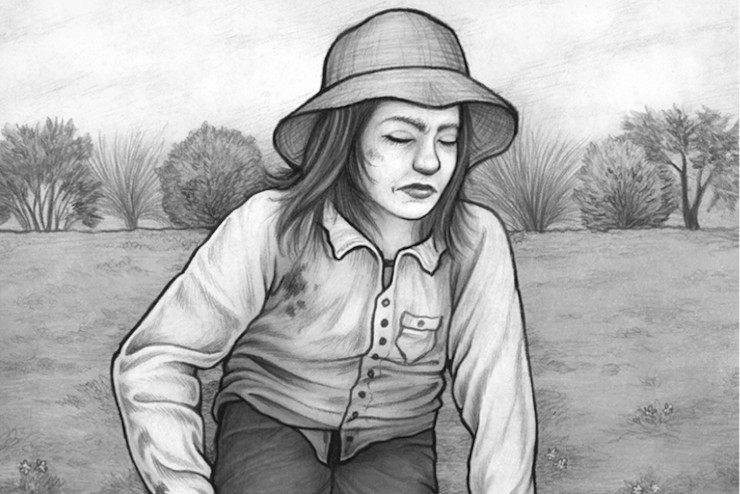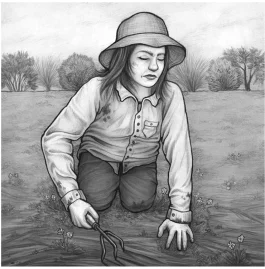
Today’s story, “Too Much Moss” gave me a chuckle because it’s so relevant to me right now. I have been trying to grow moss in my flower garden for years to wrap around the stepping stones and keep a tidy path. But if I’m being perfectly honest, I haven’t been “trying” all that hard. I knew the area probably got too much sun and all I did was blend up some moss and pour it over the steps like the Internet told me to.
Spoiler alert: That didn’t work.
So this summer, I had an idea. What if I tried a real moss starter over each rock and waited for it to take root? And you know what? It worked! The moss started growing right away, and within a few months, my rocks and pathway were completely covered in green moss. I love it.
It’s been a few months now, and my moss is still thriving. In fact, it has even spread to other parts of the area which is perfectly fine with me because I love a nice soft velvet carpet in my flower garden. If only I had thought of it sooner!
Today’s piece is a much bigger and grander story about someone who is trying to kill moss but then wants to grow moss later on. I think you’ll get a kick out of it!
More Joy in the Garden
This story comes from our archive that spans over 30 years and includes more than 130 magazine issues of GreenPrints. Pieces like these that turn the joy of gardening into everyday life lessons always brighten up my day, and I hope this story does for you as well. Enjoy!

Too Much Moss
I couldn’t get rid of it!
By Mary Whitsell
Today I noticed that the moss on our lawn is at least two inches deep, maybe more. No matter that I raked it up two dozen times last year, it always seems to come back thicker, greener, and stronger.
Moss grows freely here in Scotland, the land of endless rain. Virtually everywhere you go, you can find moss frothing up between cracks in the pavement, lying thickly on stone walls, growing in bright green clumps on people’s driveways. In our garden, the moss grows rich and luxuriant, thick as layers of plush shag carpet piled on top of each other. It smothers rocks and paving stones, renders walkways lethally slippery, and creeps up the sides of our compost bin.
A couple of years ago, I did a lot of research on moss and how you could get rid of it without using fungicides. The trick, I was told, was to use brute force and never, ever give up. So I went outside armed with a fine-pronged rake and willful intent, and I expended great energy. I went over every square inch of our turf, working up quite a sweat as I raked out every single smidgen of moss until nothing was left. Unfortunately, when I was finished, hardly anything was left of our lawn either: Only a few dozen sparse little tufts of grass, sickly and wretched, remained. At some point, the grass had been virtually smothered by moss, and I hadn’t even realized it.
For the next several weeks, I stared glumly out at the great brown patches where our grass had been and felt my spirits plummet. At least with the moss there, our front lawn had looked green. Now it looked like a bald man with an ill-advised comb-over.
I knew I had to replant the grass, but like getting rid of the moss, it was going to be a big job. Whoever had done it before had left all the rocks and tree roots. I wanted a perfect lawn, which meant I would have to do it right.

So over the next three weeks, I dug up our front lawn, carefully removing large stones, moss-resistant weeds, and tree roots, and reseeding the whole area with special shade-loving grass seed. The robins were thrilled: With all that digging, I’d made it a lot easier for them to find worms. The cat was thrilled, too: more robins to try and catch, plus a whole new toilet space! I stuck dozens of sharp sticks here and there to keep the cat out. When I wasn’t out there to stop her, she sashayed right past them and did her business. My only consolation was that she did manage to scare away some of the birds that were gobbling up what grass seed she didn’t spoil.
The grass, when it finally grew in, was sparse and pitiful. The moss, when it grew back, was strong and vigorous.
Defeated, I gave up. In no time at all, our garden was once again a moss paradise.
“You’re still determined not to use moss killer?” my neighbor Jeannette asked one morning as we surveyed my front yard. Jeannette lives a few blocks away. She and her husband have a wide, sloping lawn the size of a bowling green that is verdantly green and weed-free. They scarify and fertilize it so religiously it might as well be a golf course, and any dandelion that dares to show its head is instantly zapped with glyphosphate.
“Yep,” I said. “No moss killer for me.” Jeannette’s lawn is beautiful to look at, but I’d be nervous to sit on it.
“Ah well,” Jeannette said. “Moss does make a nice, cushioned turf—that’s one thing you can say about it.”
I stared at her. Jeannette was absolutely right. Whenever I walked on our mossy front lawn, I was aware of how soft and comfortable it was, how my feet sank right into it—like walking on an expensive wool carpet. In fact, the more I thought about it, the more I began to see that there are a lot of good things about moss. First of all, not only does it grow vigorously without fertilizer, but even when you accidentally rake it up with your autumn leaves, it grows right back. It is green and beautiful. In the spring, birds line their nests with it. Gardeners can use it in hanging baskets. It keeps the weeds down and it costs you nothing. Plus it never needs mowing, and in Scotland, it certainly never needs watering. Perfect, really.
Suddenly I was nine years old, in California, and going with my father to the Riverside County fair. Usually I found county fairs tiresome events with boring displays, too many people, and far too much heat. My father would invariably get caught up in some conversation about growing avocados, grafting citrus trees, or irrigation, and I would wait in the sun, bored out of my mind.
At first, this time was no different. I spent the first hour trail-ing miserably after my father, wishing I’d stayed at home. Then I stumbled upon a display of lawn turfs and ground covers, and suddenly I was fascinated. There was a glass case with real, individual turfs with labels explaining what each one was and how it should be cared for. My absolute favorite was Scotch moss, a rich, lime green, as soft and springy to the touch as the thickest velvet. I stuck out a greedy finger and gasped at the plush softness, the delicious coolness. There was no doubt in my mind: Scotch moss beat Bermuda grass hands down. I could picture myself rolling around in it on a hot summer day: I wanted some!
As soon as I could drag my father away from his discussion on the merits of different fertilizers, I showed him the turf and ground cover displays and made my plea. He and the turf lady smiled indulgently. “This one isn’t really practical for Southern California,” the lady told me. “You’d have to plant it in a shady area and water it five times a day, and to be honest, it would still probably die. Too much sunlight and heat aren’t good for it.” My father agreed with her, pointing out how expensive it was, but it took him at least 20 minutes to drag me away from the display. When we got home, I stood in front of our house and balefully regarded our front yard, hating our parched, bedraggled, yellowing Bermuda grass. I pictured Scotch moss growing abundantly, a delicious carpet of moist, plush green, cool and refreshing under my bare feet. We had sharp, prickly grass that needed to be watered all the time and still looked pathetic. But somewhere in the world people walked on a living carpet of soft, springy moss that never needed watering. Lucky, lucky people.
A few decades later, I ended up in Scotland with Scotch moss coming out of my ears. And yet for a while there, I was raking it up like nobody’s business, desperate to get rid of it. It’s crazy, really. Why do we tend to want plants that are hard to grow but have little interest in the ones that thrive effortlessly in our gardens? Well, enough of that! I went outside, kicked off my shoes…and rolled in it. ❖
By Mary Whitsell, published originally in 2016, in GreenPrints Issue #105. Illustrated by Kate O’Hara

Did this remind you of a similar story in the garden that you’d like to share? Leave a comment below, I’d love to hear it.



